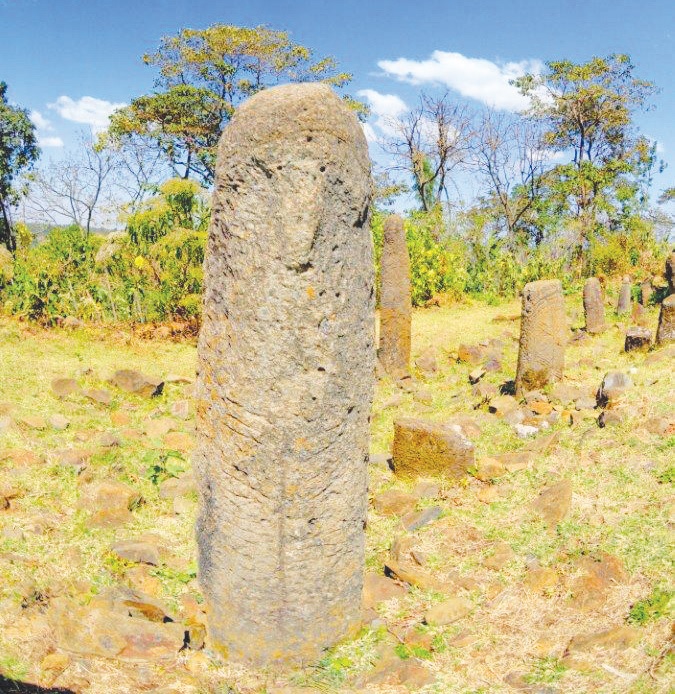
BY LAKACHEW ATINAFU
From time immemorial and indistinct chronology, time seemed to have been a bonding entity that ties Ethiopia with rock and architectures. This is manifested by a number of impressive stelas and archeological remains that were crafted artistically by Ethiopians, covering nearly the whole astronomical location of the country.
One may conjure up why the country is part and parcel of rock civilization which call for further archeological findings and helpful discoveries.
It is obvious that Ethiopia is an ancient nation that crawl the journey towards modern time among other Oriental and Minor Asia with robust diplomatic and economic ties.
Hence the aim of this piece is to uncover the age long and untold archeological sites of Tutiti and Tutu Fela Stelae in the Gedio Zonal Administration of the South Ethiopia Nation Nationalities and Peoples’ State. (SNNPS).
As one drives from Addis Ababa, Capital of Ethiopia, to down south on the main road to Nairobi, there are numerous stelae which are identified as the local people signifying them genital organs of male and female erected on graveyards. According to oral traditions and hypothesis the stelae have long been served to identify graveyards of deceased males from females.
Eshetu Worku, Gedio Zone Communication Expert told The Ethiopian Herald that as one observes the district of South Ethiopia particularly Dila District, he/she would get themselves in the realm of stelaes which identified genital organs of male and females erected at areas supposed to be ancient grave yards of the local community.
According to the Expert the stelaes are very carefully gathered at the outskirt of Dila and Yirgachefe the other prominent towns of Arbaminch.
According to him there are about 300 stealeas around the town of Dila while there are yet thousands of them found in other areas which need further scientific investigation and discoveries to add something to humanity.
The communication Expert called on Ethiopians and the international community to pay a visit and contribute their effort to promote the untapped tourism potential of the State and add something worth to its archaeological significance.
In fact, the country is home to various stelaes from Axum to Tiya to Tutiti Tutu Fela, the case in the south still demands further studies as local and international communities put emphasis upon the former, said Eshetu.
So the name Tutiti Tutu Fela as many of the places has no semantic relation with the object it represents, it is only the site named after the place which preserved such mystic heritages.
To get to the area of Tutu Fella, one need to head south from Addis Ababa, traveling 350 km towards the city of Dila, located nearby walking along the broad trail, more like a primitive road, for 1-2 km to reach the destination. False banana trees, Ensete ventricosum, Ethiopia’s most important root crop, lined the walkway to reach the destination mesmerizing at other natural resources the district is blessed with, the Expert insisted.
But nobody seems to know the particularity of Tutu Fella. Do they mark graves? Not obviously so. Was it a place of worship? Did somebody haul in all the rocks in which to place the stelae? How long have they been there?
As it has been tried to present on the above, there is no yet clear justification about such heritages apart from hypothesis and oral traditions; however no one can deny that the area is one of the past human dwells that they had been doing their toil on the planet so that it needs further investigation.
As to scholars and elders of the community around, the stelaes look like more craved stones to signify the sex of the deceased. That is why they took after images and shapes identical organs of either male or female.
In Ethiopia, there are several stelae fields, the most important of which are in the Axum area. The tallest Axum Stelae that is still standing is 24.6 meters in height. The tallest of all was 33 meters, and is thought to have fallen during the erection process.
Stelae in Ethiopia are all carved from a single piece of granite, and then erected at the chosen location. Construction of the stelae was carried out approximately 5000 years ago, until about 1600 years ago, so there is no written or verbal record of their exact purpose. Certainly, some of the largest ones were grave markers. Others announced the importance of local rulers. The function of many others is more obscure.
It has been suspected even the immediate neighbors do not have the answers, and it has not being thought of the area is used in any particular way by modern peoples. For naturalists obsessed with understanding and identifying all that erected around Dila, a visit to the steal field of Tutu Fella was a good reminder that they would have a lot to learn about the past.
Since recent time, state governments along with local administrators, relevant authorities and the public at large are vigorously working and put in place activities to make the area tourist attraction and preferred archeological site. Thus, the government has due emphasis
for the expansion of infrastructure and other needed facilities to make the district part and parcel of tourism and archeology potential.
Above all, the country is the land of origin particularly the home of rock civilization that binds together the diverse nation from east to west and north to south.
The Ethiopian herald December 24/2020




